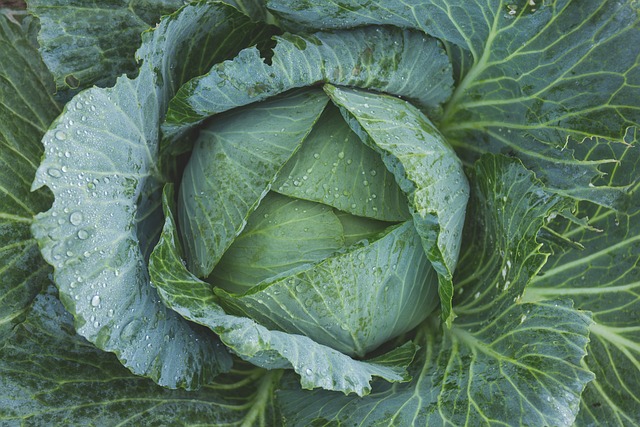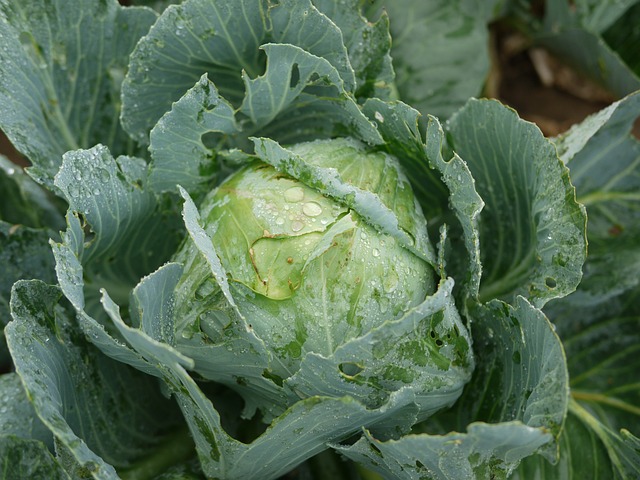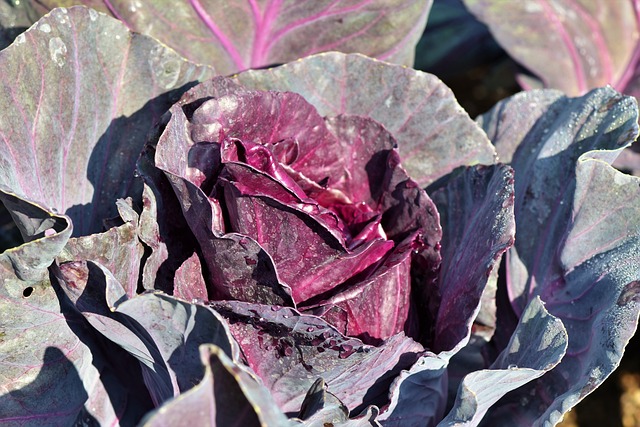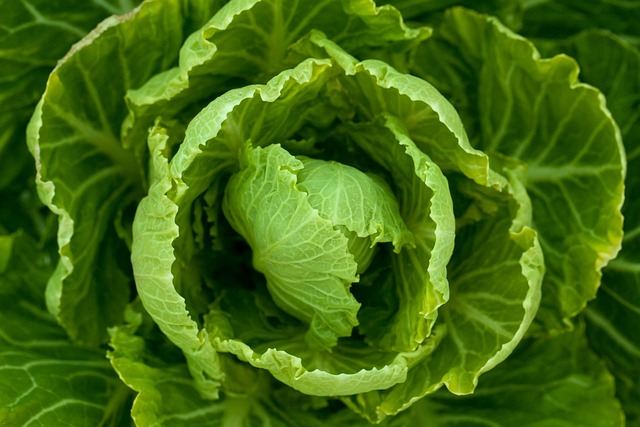White spots on cabbage leaves can be an alarming sight for gardeners and farmers. These spots can occur due to various reasons, including diseases, nutrient deficiencies, and environmental factors. Understanding the cause behind these spots is crucial to identifying the appropriate treatment and prevention measures.
Several diseases can cause white spots on cabbage leaves, including downy mildew, white leaf spot, and white mold. These diseases can cause circular or irregular spots on the leaves that may merge and lead to the death of the plant. Identifying the specific symptoms of these diseases can help in early detection and control.
Apart from diseases, environmental factors such as high humidity, low light, and extreme temperatures can also cause white spots on cabbage leaves. Nutrient deficiencies and excessive use of fertilizers can also contribute to the problem.
Preventive measures such as proper crop rotation, soil management, and timely fertilization can help reduce the incidence of white spots on cabbage leaves.
Key Takeaways
- White spots on cabbage leaves can be caused by diseases, nutrient deficiencies, and environmental factors.
- Identifying the specific symptoms of diseases such as downy mildew and white mold can help in early detection and control.
- Preventive measures such as proper crop rotation, soil management, and timely fertilization can help reduce the incidence of white spots on cabbage leaves.
Also don’t miss:
Understanding White Spots on Cabbage Leaves

White spots on cabbage leaves are a common problem for gardeners and farmers. These spots can appear as small, circular patches or large, irregular shapes on the leaves. The spots are a sign of discoloration and often indicate a problem with the plant’s chlorophyll production.
Symptoms of white spots on cabbage leaves include the development of white or pale patches on the leaves. The spots may be accompanied by yellowing or browning of the surrounding tissue. In some cases, the spots may become sunken or raised, and the leaves may become distorted or deformed.
There are several possible causes of white spots on cabbage leaves, including nutrient deficiencies, sunburn, and damage caused by pests or diseases. Nutrient deficiencies, particularly in nitrogen and potassium, can cause the leaves to turn white or yellow.
Sunburn can also cause white spots on cabbage leaves, especially if the plants are exposed to direct sunlight for extended periods of time.
Pests and diseases can also cause white spots on cabbage leaves. For example, downy mildew and white mold can cause white or grayish patches on the leaves. Alternaria leaf spot is another common disease that causes circular, dark spots with white centers to develop on the leaves.
Common Diseases Causing White Spots
White spots on cabbage leaves can be caused by various diseases, including fungal, bacterial, and viral. Understanding the underlying cause of the white spots is essential to take the necessary steps to prevent further damage to the cabbage crop.
Fungal Diseases
Fungal diseases are one of the most common causes of white spots on cabbage leaves. Two of the most common fungal diseases are powdery mildew and downy mildew.
Powdery mildew is a fungal disease that appears as a white or gray powdery coating on the leaves, while downy mildew appears as yellow or white spots on the leaves. White rust is another fungal disease that causes white spots on cabbage. It appears as white pustules on the leaves and can cause significant damage to the crop.
Bacterial Diseases

Bacterial diseases can also cause white spots on cabbage leaves. Bacterial leaf spot is a common bacterial disease that causes white spots on the leaves. The disease appears as small, water-soaked spots that turn white as they mature.
Another bacterial disease that causes white spots on cabbage is white leaf spot. It appears as small, white spots on the leaves that eventually enlarge and merge to form larger spots.
Viral Diseases
Several viral diseases can cause white spots on cabbage leaves. The most common viral disease is the cauliflower mosaic virus, which causes white spots on the leaves and stunted growth of the plant.
Another viral disease that causes white spots on cabbage is the turnip mosaic virus. It appears as white spots on the leaves, and infected plants may have distorted leaves and stunted growth.
It is essential to identify the underlying cause of the white spots on cabbage leaves to take the necessary steps to prevent further damage to the crop. Preventive measures such as crop rotation, proper irrigation, and good sanitation practices can help prevent the spread of fungal, bacterial, and viral diseases.
Affected Cruciferous Plants
White spots on cabbage leaves are a common problem that can affect other cruciferous plants as well. Cruciferous vegetables are members of the Brassicaceae family and include cabbage, cauliflower, broccoli, radish, turnip, kale, mustard, and collards, among others.
These plants are popular for their nutritional value and are widely grown in home gardens and commercial farms.
White spots on cabbage leaves are caused by a variety of fungal diseases, including Alternaria leaf spot, white mold, and white rust. These diseases can also affect other cruciferous plants, such as cauliflower, broccoli, and radish.
The symptoms of these diseases include circular white spots on the leaves, stems, or pods of the plants. Older spots may develop dark borders, and the centers may fall out, giving them a shot-hole appearance.
In addition to fungal diseases, cruciferous plants can also be affected by cruciferous weeds, such as wild radish, wild mustard, and shepherd’s purse. These weeds can harbor pests and diseases that can spread to your cruciferous plants, leading to white spots on the leaves.
Horseradish, rape, and collards are also members of the Brassicaceae family and can be affected by the same diseases as other cruciferous plants.
To prevent white spots on your cruciferous plants, it is important to practice good garden hygiene. This includes removing any plant debris from the garden area, as well as rotating your crops each year.
Avoid planting cruciferous plants in the same spot for more than two years in a row, as this can increase the risk of fungal diseases.
Identifying Specific Symptoms

White spots on cabbage leaves can be caused by a variety of factors, including fungal and bacterial infections, insect damage, and nutrient deficiencies. Here are some specific symptoms to look for when trying to identify the cause of white spots on cabbage leaves:
1. Circular lesions
White spots caused by fungal infections often appear as circular lesions on the leaves. For example, white spot fungus presents as circular to irregular spots that range from ¼ to ½ inch (6 mm. to 1 cm.) across and scattered across the leaf.
It begins as light tan, dry spots and soon turns to papery white lesions on the leaf surrounded by a halo of yellow or pale green. The spots grow and merge.
2. Yellow leaves
If the white spots are accompanied by yellowing of the leaves, this may indicate a nutrient deficiency. Calcium deficiency is a common cause of white spots on cabbage leaves.
If the leaves lighten or are turning white, this means that the cabbage lacks calcium and potassium. Fertilizing with homemade infusions such as banana peel infusion and wood ash can help alleviate this issue.
3. Purple leaves
If the white spots are accompanied by purple or reddish discoloration of the leaves, this may indicate a sunburn. Cabbage plants can be sensitive to high levels of sunlight, especially during the summer months. To prevent sunburn, it’s important to provide adequate shade and water the plants regularly.
4. Cankers
White spots on cabbage leaves can also be caused by bacterial infections, which often manifest as cankers on the leaves. Cankers are areas of dead tissue surrounded by a reddish-brown border.
They can be caused by a variety of bacteria, including Pseudomonas syringae pv. maculicola, which causes bacterial leaf spot on cabbage plants.
Role of Environmental Factors
Environmental factors play a crucial role in the development of white spots on cabbage leaves. Here are some of the factors that can contribute to the formation of these spots:
Temperature

Cool temperatures can favor the growth of fungi that cause white spots on cabbage leaves. According to the University of Minnesota, the ideal temperature for the development of downy mildew is between 50°F and 68°F. In contrast, temperatures above 77°F can inhibit the growth of the fungus.
Watering
Watering practices can also affect the development of white spots on cabbage leaves. Overhead watering or splashing water on the leaves can create a humid environment that favors the growth of fungi. It is recommended to water the plants at the base to avoid wetting the leaves.
Air Circulation
Poor air circulation can also contribute to the development of white spots on cabbage leaves. When the air is stagnant, moisture can accumulate on the leaves, creating a favorable environment for fungi to grow. It is recommended to space the plants adequately and prune any nearby vegetation to improve air circulation.
Wind
Wind can also affect the formation of white spots on cabbage leaves. Strong winds can damage the leaves, creating entry points for fungi. On the other hand, gentle winds can help improve air circulation and reduce the risk of fungal growth.
Prevention and Control Measures
When it comes to preventing and controlling white spots on cabbage leaves, there are several measures that can be taken. These measures can be broadly classified into cultural practices, chemical control, and biological control.
Cultural Practices
Cultural practices play a crucial role in preventing and controlling white spots on cabbage leaves. Crop rotation is an effective way to prevent the buildup of pathogens in the soil.
It is recommended to rotate cabbage crops with non-cruciferous crops such as legumes, corn, or potatoes. Sanitation is also important in preventing the spread of disease. Gardeners should remove and destroy any infected plant debris and weeds. Disease-free seeds should be used for planting.
Drip irrigation is a better option than overhead watering as it reduces the chances of fungal infections. Good soil drainage is important to prevent waterlogging. It is also recommended to avoid planting cabbage in areas where water tends to accumulate.
Chemical Control

Chemical control measures can be used to prevent and control white spots on cabbage leaves. Fungicides can be used to control the spread of disease. However, it is important to note that the use of fungicides should be a last resort.
Gardeners should always follow the instructions on the label and apply the fungicide at the recommended rate.
Biological Control
Biological control measures involve the use of natural enemies to control the spread of disease. Beneficial insects such as ladybugs and lacewings can be introduced into the garden to control the spread of aphids and other pests. Additionally, compost tea can be used to promote the growth of beneficial microorganisms in the soil.
In summary, preventing and controlling white spots on cabbage leaves requires a combination of cultural practices, chemical control, and biological control measures. Gardeners should follow good sanitation practices, use disease-free seeds, practice crop rotation, and use drip irrigation to prevent the buildup of pathogens in the soil.
When chemical control measures are necessary, fungicides should be used as a last resort and applied according to the instructions on the label. Biological control measures can also be used to control the spread of disease.
Role of Fertilizers and Nutrients
Fertilizers play a crucial role in the growth and development of cabbage plants. Nitrogen is one of the most important nutrients for cabbage, as it helps in the formation of leaves and heads. However, an excess of nitrogen can lead to the development of white spots on cabbage leaves.
Phosphorus is another essential nutrient for cabbage plants. It helps in the development of strong roots and promotes the growth of healthy leaves. A deficiency of phosphorus can result in stunted growth and yellowing of leaves, which can eventually lead to the development of white spots.
Nutrient deficiencies can also cause white spots on cabbage leaves. Magnesium deficiency, for example, can result in the formation of white spots on the leaves. This nutrient is essential for the development of healthy leaves and helps in the formation of chlorophyll.
Calcium deficiency can also lead to the development of white spots on cabbage leaves.
Organic matter can also play a role in the development of white spots on cabbage leaves. Adding organic matter, such as compost or manure, to the soil can help improve soil fertility and promote healthy plant growth.
When using fertilizers, it is important to follow the recommended application rates. Over-fertilization can lead to nutrient imbalances, which can cause a variety of problems, including the development of white spots on cabbage leaves.
Treatment Options

If the white spots on cabbage leaves are caused by a fungal infection, there are several treatment options available. One option is to apply a copper fungicide, which can help prevent the spread of the fungus. Copper is a natural fungicide that is effective against a wide range of fungal diseases.
Some popular brands of copper fungicides include Bonide Copper Fungicide and Southern Ag Liquid Copper Fungicide.
Another option is to use a biopesticide, which is a natural product that contains living organisms that can help control plant diseases. Biopesticides are often safer and more environmentally friendly than traditional chemical pesticides.
Some popular brands of biopesticides for controlling fungal diseases on cabbage include Serenade Garden Disease Control and Monterey Garden Insect Spray.
In addition to fungicides and biopesticides, there are also some cultural practices that can help prevent and control fungal diseases on cabbage. For example, it is important to keep the area around the cabbage plants clean and free of debris, as this can harbor fungal spores.
It is also important to water the plants at the base, rather than from above, as this can help prevent the spread of fungal diseases. If the white spots on cabbage leaves are caused by a nutrient deficiency, such as a lack of calcium or potassium, then fertilization may be necessary.
Homemade infusions such as banana peel infusion and wood ash can be used to fertilize the cabbage plants. It is important to follow the recommended application rates for these infusions to avoid over-fertilization.
Post-Harvest Storage and Handling
Cabbage is a hardy vegetable that can be stored for several months if harvested and stored properly. However, improper handling and storage can lead to the development of white spots on cabbage leaves. These spots are caused by a fungal disease called Sclerotinia sclerotiorum, which thrives in cool, humid conditions.
To prevent the development of white spots, it is important to ensure that the cabbage is dry before storage. Any moisture on the leaves can create a breeding ground for fungi and bacteria. After harvesting, the cabbage should be left in the field for a few hours to dry before being moved to storage.
Cabbage should be stored in a cool, dry place with good ventilation. The ideal temperature for cabbage storage is between 32°F and 40°F (0°C and 4°C). At this temperature, the cabbage can be stored for up to two months.
However, if the temperature drops below 32°F (0°C), the cabbage can become damaged and develop frostbite.
To prevent damage during storage, cabbage should be handled carefully. It should not be dropped or stacked too high, as this can cause bruising and damage to the leaves. It is also important to inspect the cabbage regularly for signs of decay or disease, and to remove any damaged leaves or heads immediately.
In addition to proper handling and storage, it is important to harvest cabbage at the right time. Cabbage should be harvested when the heads are firm and dense, with no visible signs of damage or disease. Overripe or damaged cabbage is more susceptible to disease and decay, and should be discarded.
Frequently Asked Questions
How do you treat white spots on cabbage leaves?
Treating white spots on cabbage leaves depends on the underlying cause. If the spots are caused by a fungal disease, such as powdery mildew or downy mildew, it’s important to remove the affected leaves and destroy them to prevent the disease from spreading.
Fungicides may also be used to control the disease. If the spots are caused by a nutrient deficiency, such as a lack of calcium, adding the necessary nutrients to the soil can help prevent further damage to the plant.
Can you eat cabbage with white spots?
It is generally safe to eat cabbage with white spots, as long as the spots are not caused by a disease or pesticide. However, the affected leaves should be removed and discarded before consuming the cabbage.
What are the white spots on my cabbage?
The white spots on cabbage can be caused by a variety of factors, including fungal diseases, such as powdery mildew or downy mildew, or nutrient deficiencies, such as a lack of calcium or magnesium.
What are the spots on my cabbage leaves?
The spots on cabbage leaves can be caused by a variety of factors, including fungal diseases, such as powdery mildew or downy mildew, or insect infestations, such as diamondback moth larvae. The spots can also be caused by nutrient deficiencies, such as a lack of calcium or magnesium.
Are white spots on rocket leaves safe to eat?
White spots on rocket leaves can be caused by a variety of factors, including fungal diseases or insect infestations. It is generally safe to eat rocket leaves with white spots, as long as the spots are not caused by a disease or pesticide.
However, the affected leaves should be removed and discarded before consuming the rocket.
How can you tell if white spots on leaves are caused by nutrient deficiency?
White spots on leaves caused by nutrient deficiency are typically uniform in size and shape, and can appear on multiple leaves throughout the plant. The spots may also be accompanied by other symptoms, such as yellowing or curling of the leaves.
A soil test can help determine if the plant is lacking in any nutrients, and the necessary nutrients can be added to the soil to prevent further damage to the plant.

Hey, I’m Lisa and I’ve been an avid gardener for over 30 years. I love writing, talking and living in the garden! Feel free to connect with me on my socials below

